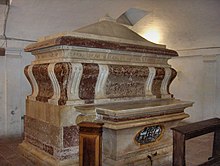Fortunatus of Todi
Fortunatus von Todi († 537 in Todi ) was, according to tradition, the bishop of the city in Umbria . Along with Saints Callisto and the sisters Romana and Firmina, he is the patron saint of Todis and became known as a miracle healer through the reports of Pope Gregory I (590-604), who claims to have questioned contemporaries of Fortunatus.
In his dialogues, the Pope reports that Fortunatus had "an immense power and grace in driving out evil spirits". He had "sometimes cast out legions of demons from the possessed" and "through uninterrupted prayerful enthusiasm for whole multitudes of them when they opposed him." When a woman went to church consecration without abstaining sexually, she was attacked by the devil. Her relatives tried to have them freed from him by magicians , but this failed, so they handed over the woman to Fortunatus, who freed her by praying for days. A man whom Fortunatus had shown the door but who was the devil complained of this lack of hospitality. A couple with their son welcomed him not out of hospitality, but out of joy “at the gossip against the bishop”. Hence the devil killed her son. The father only wanted “it would appear that he was acting better than the bishop, since he had taken one in and chased away Fortunatus, the Lord's man”. Fortunatus restored the eyesight of another man, soothed an angry horse, healed leprosy , brought the dead to life, like an otherwise unknown Marcellinus. When a Goth kidnapped two children and they refused to hand them over, he fell from his horse and broke his hip, which in turn was healed by holy water, as Gregor reports, who claims to have learned this from an eyewitness.
These anecdotes show that the release of prisoners in northern Italy, for example, was part of the episcopal caritas as in Gaul . They also prove the continued existence of non-Christian magicians, who were often called upon for help. However, they also show that, according to Gregory, the focus should not be on the external action, but on the intention on which this action is based.
Fortunatus embodies one of the saint types of the epoch after the martyrs of the time after the persecution of Christians , similar to the anchorites , who pointed beyond everyday life through their way of life.
The bishop was usually depicted as bearded and in official regalia, as for example by Pietro Paolo Sensini (1555-1632). The church of San Fortunato in Todi, consecrated to him, is a major work of Italian Gothic from the 13th / 14th centuries. Century. The previous building (San Cassiano) reached back to the 6th century. In the church are the bishop's relics in an urn by Angelo Cesi from 1596.
Already in Gregory's time Fortunatus was called for healing and his relics were touched. His memorial was Usuardus Sangermaniensis set to October 14, but the Fortunatus with St. Fortunata is said to have mistaken a martyr in Palestine the time of Emperor Diocletian .
There is also a relic in the baroque church of Baar-Ebenhausen in Upper Bavaria.
literature
- Elia G. Manieri: Conservato e perduto nelle chiese minoritiche di fondazione duecentesca , 2. San Fortunato di Todi , in: Cantiere pittorico, Assisi 2001, pp. 336–347.
- Enrico Menestò: L'inventario del 1435 della biblioteca del convento francescano di San Fortunato di Todi , in: Pier Lorenzo Meloni, Ugolino Nicolini (ed.): Studi sull'Umbria medievale e umanistica in ricordo di Olga Marinelli , Fondazione CISAM, 2000, P. 273ff. (Book lists, almost 400 works)
- Guglielmo De Angelis d'Ossat, Mario Pericoli: Il Tempio di San Fortunato a Todi , Silvana, Milan 1982.
Web links
- Entry on santibeati.it (quote from the Martyrologium Romanum , Italian)
- Entry in French on nominis.cef.fr
Remarks
- ↑ This and the following from: Dialogi de vita et miraculis patrum Italicorum , Book 1, quoted after the translation in the library of the church fathers ( chapter: From Fortunatus, the Bishop of Todi ) Gregory the Great: Four dialogues. Chapter X: Retrieved on May 4, 2015 by Fortunatus, Bishop of Todi .
- ^ Marie-Luise Laudage: Caritas and Memoria Medieval Bishops , Böhlau, 1993, p. 38.
- ^ Ruggero Iorio: Le origini delle diocesi di Orvieto e di Todi alla luce delle testimonianze archeologiche , Porziuncola, 1995, p. 151.
| personal data | |
|---|---|
| SURNAME | Fortunatus of Todi |
| BRIEF DESCRIPTION | Bishop of the city of Todi in Umbria |
| DATE OF BIRTH | 5th century or 6th century |
| DATE OF DEATH | 537 |
| Place of death | Todi , Italy |



